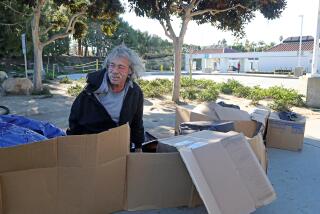Clearing the benches
- Share via
SANTA BARBARA — Cities have tried many ways to move panhandlers and vagrants out of prime shopping districts, but Santa Barbara believes it has a new angle -- 90 degrees.
Using $50,000 in redevelopment funds, the city is planning to turn 14 benches perpendicular to the State Street storefronts they now face. The idea is to make it more difficult for beggars to establish contact with passersby, officials said.
“They’ll be sitting with their backs to half the people coming and going on the sidewalk,” said Marck Aguilar, a supervisor for the city’s redevelopment agency. “They’ll have half the potential contacts with the public. It might not be financially beneficial for them.”
To discourage prolonged stays, Aguilar said, workers will also remove the backs from several benches on a two-block stretch of the city’s most vibrant commercial thoroughfare. If the pilot program succeeds, it may be extended the length of the street, where crowds of students and well-heeled tourists from around the world amble into upscale stores and restaurants.
The idea, which originated with the Santa Barbara Downtown Organization, a business group, has again focused attention on Santa Barbara’s efforts to deal with its sizable homeless population.
“This is the kind of step that people who want to do something about the problem have been forced to in desperation,” said City Council member Dale Francisco, a conservative voice in a largely liberal town. “For a long time, political actors have been against doing anything to reduce the number of homeless people on the street.”
But Ken Williams, a county social worker and impassioned advocate for the homeless, called the idea “rearranging deck chairs on the Titanic.”
“You can flush them off of State Street and they’ll go to the east side or the beaches,” he said. “It doesn’t do any good.”
Four of Santa Barbara’s homeless people have died since Jan. 1, and 32 died last year. The bench project’s $50,000 would be better used to provide services, Williams said: “We’re talking benches versus homeless deaths? That’s nuts!”
Benches have been an issue elsewhere. Some cities install armrests in the middle of benches to keep people from lying down. In La Jolla two years ago, one community activist tried recruiting residents to sit three-hour shifts to keep homeless people off public benches.
In Santa Barbara, workers are to start relocating the loveseat-sized, Mission-style wooden benches in May, unbolting them from concrete pads beneath the red brick sidewalks. Some will face each other, forming a kind of conversation pit -- and further limiting their view of the passing parade. Redoing the concrete and brickwork accounts for much of the $50,000 tab, officials said.
On a recent afternoon, benches on the two target blocks were occupied by high school water polo players in town for a tournament, a woman changing a baby’s diaper and a woman eating an ice cream cone.
A trio of scruffy young people on neighboring benches were making ‘Got Change?’ signs; and 60-year-old Paul Johnson, who said he spends most of his days on a bench near a closed Borders bookstore, was changing his socks, revealing bloody scrapes on his feet.
“That’s just stupid,” he said of the bench plan.
“It won’t do a thing and it’s another slap in the face of homeless people.”
Johnson sat beside a rolling rack loaded with his coats, neatly folded sweatshirts, a bookshelf filled mostly with religious works and some homemade signs with mystical aphorisms such as “God Is Love -- but Love Is not God.”
He said he prides himself on not asking for money directly, but a nearby business owner who asked not to be identified because of the issue’s “sensitivity” said panhandling is only part of the problem.
“It’s just like they’ve made the street their living room,” she said. “They just sit there -- all day, every day. One of them even has a portable TV. It’s totally inappropriate.”
Dave Lombardi, a Santa Barbara Downtown Organization board member, said people camping on benches create a negative impression that upsets visitors and residents alike.
“We shouldn’t have to be accosted or afraid when we go downtown,” he said, adding that, with a variety of programs to aid the homeless, Santa Barbara is “a very compassionate town.”
From where Johnson sits, that’s not always the case.
“This town is a contrast between the super-rich and the desperately poor,” he said, surveying the crowd strolling on State Street.
--
More to Read
Sign up for Essential California
The most important California stories and recommendations in your inbox every morning.
You may occasionally receive promotional content from the Los Angeles Times.











